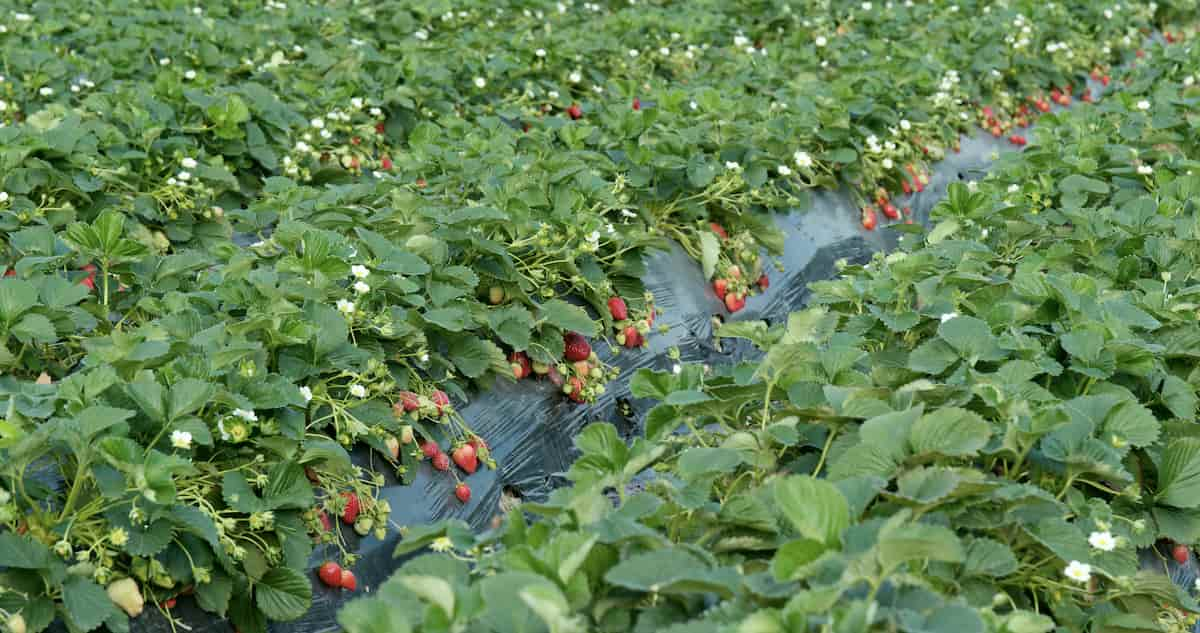Strawberry farming is a lucrative and rewarding venture for farmers who want to diversify their crop production. Strawberries are a popular fruit consumed fresh, frozen, or processed into jams, jellies, and syrups. The United States is the world’s largest strawberry grower, and domestically grown strawberries are in high demand. Below we learn about Strawberry cultivation in the USA, Strawberry production procedure, and a step-by-step guide to starting your Strawberry farm in the US.

How to Start Strawberry Farming in the USA
Location
The first step in starting a strawberry farming business is to choose a suitable location. Strawberries grow best in areas with moderate temperatures and plenty of sunlight. They also require a well-drained soil that is rich in organic matter. If your soil is not suitable for strawberry farming, you may need to amend it by adding compost or other organic matter.
When choosing a location for your strawberry farm, it’s important to consider factors such as climate, soil quality, and water availability. You can consult with local extension offices, seed companies, or experienced farmers to determine the best location for your farm.
Season
The strawberry season in the USA typically runs from late spring to early summer. This is when strawberries are in high demand, and prices are usually higher than at other times of the year. The exact timing of the strawberry season can vary depending on the region, so it’s important to consult with local extension offices or experienced farmers to determine the best time to plant and harvest your strawberries.
Variety
Many different varieties of strawberries are available, each with its unique characteristics. Some varieties are better suited to certain regions, while others are better for specific uses, such as fresh eating or processing. When choosing a variety, it’s important to consider factors such as climate, soil type, and intended use. Some popular strawberry varieties in the USA include:
- Chandler: A high-yielding, large-fruited variety that is popular for fresh eating
- Camarosa: A large-fruited variety that is popular for both fresh eating and processing
- Albion: A day-neutral variety that produces large, firm fruits throughout the growing season
- Seascape: A day-neutral variety that produces high yields of large, flavorful fruits
Prepare the Land
Once you have chosen a suitable location and variety, it’s time to prepare the land. Strawberry farming requires well-prepared soil that is free from weeds and other debris. You can prepare the land by tilling the soil, removing any weeds or debris, and creating raised beds. Raised beds are ideal for strawberry farming because they provide good drainage and allow for easier harvest. They also help to minimize soil erosion and reduce the risk of disease.
Planting
The best time to plant strawberries is in the fall, so they have time to establish their roots before the winter. You can plant strawberries in rows or a matted row system. In the matted row system, you plant the strawberries closer together and allow them to spread out and create a mat of plants. When planting strawberries, it’s important to space them correctly to ensure good airflow and prevent disease. You should also ensure the plant crown is at soil level and the roots are well-covered.
Irrigation and Fertilization
Strawberries require regular watering, especially during the growing season. Strawberries benefit most from drip irrigation because it allows water to be delivered directly to the plant’s roots while reducing runoff. Overhead irrigation can cause water to sit on the leaves, increasing disease risk. Strawberries also require regular fertilization to maintain healthy growth. A balanced nitrogen, phosphorus, and potassium fertilizer is ideal for strawberry farming. You can use a drip irrigation system or broadcast fertilizer over the soil.
In case you missed it: How to Grow Strawberries in Greenhouse: A Step-By-Step Guide for Seed to Harvest

Pest and Diseases
Strawberries are susceptible to various pests and diseases, so it’s important to implement an effective pest and disease management program. This includes regular scouting for pests, such as aphids or spider mites, and disease symptoms, such as powdery mildew or verticillium wilt. Depending on your preference, you can use organic or chemical treatments to manage pests and diseases. Some organic methods of pest and disease management include using beneficial insects, such as ladybugs or lacewings, and organic pesticides or fungicides.
Intercropping
Growing many crops on one field is known as “intercropping.” Intercropping can benefit strawberry farming because it can help control pests and diseases, improve soil health, and increase yield. Some crops commonly intercropped with strawberries include cover crops like clover or rye and vegetables like lettuce or beans. When intercropping with strawberries, choosing crops compatible with strawberries and having similar water and nutrient requirements is important. You should also ensure that the intercropped crops do not shade or compete with the strawberries for resources.
Harvesting
Strawberries are typically ready to harvest 4-6 weeks after the flowers bloom. You can harvest them by hand or by using a machine. Harvesting the strawberries when they are fully ripe is important to ensure maximum flavor and shelf life. Ripe strawberries are bright red and easily detach from the plant when pulled. During harvesting, it’s important to carefully handle the strawberries to prevent bruising or damage. You can store the strawberries in a cool, dry place for up to 3 days or freeze them for longer storage.
Profitability
The profitability of strawberry cultivation can vary depending on several factors, such as yield, market demand, input costs, and farm management practices. However, when managed correctly, strawberry farming can be a profitable enterprise. According to research, the average yield of strawberries in the US is about 10,000 pounds per acre, with a market value of around $30,000 to $40,000 per acre. With proper planning and management, a strawberry farm can generate a substantial profit for the farmer.
In case you missed it: How to Plant Strawberry Seeds Indoors: A Step-by-Step Guide for Beginners

Conclusion
Starting a strawberry farm in the USA can be a rewarding and profitable venture. By following these steps and paying attention to the details, you can grow high-quality strawberries that meet market demand and generate a steady income. Remember to stay up-to-date with the latest trends in strawberry farming and continue to learn and improve your skills to stay competitive in the market.
- Feed Your Flock for Less: Top 10 Tips to Save on Chicken Feed
- Ultimate Guide to Ossabaw Island Hog: Breeding, Raising, Diet, and Care
- Hatching Answers: The Top 10 Reasons Your Chickens Aren’t Laying Eggs
- Eggs and Economics: Breaking Down the Cost of Raising Backyard Chickens
- Defend Your Greens: Proven Methods to Keep Iguanas Out of Your Garden
- Ultimate Guide to Cinnamon Queen Chicken: A Comprehensive Guide for Beginners
- Ultimate Guide to California Tan Chicken: Breeding, Raising, Diet, Egg-Production and Care
- Ultimate Guide to Marsh Daisy Chicken: Breeding, Raising, Diet, and Care
- 10 Types of Chicken Farming Businesses You Can Start for Profits